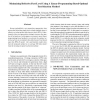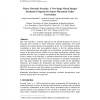1165 search results - page 1 / 233 » Effective linear programming based placement methods |
ISPD
2006
ACM
14 years 11 months ago
2006
ACM
Linear programming (LP) based methods are attractive for solving the placement problem because of their ability to model Half-Perimeter Wirelength (HPWL) and timing. However, it h...
ICASSP
2008
IEEE
14 years 11 months ago
2008
IEEE
We recently reported a criterion for blind separation of non-negative sources, using a new concept called convex analysis for mixtures of non-negative sources (CAMNS). Under some ...
ATS
2003
IEEE
14 years 10 months ago
2003
IEEE
Recent probabilistic test generation approaches have proven that detecting single stuck-at faults multiple times is effective at reducing the defective part level (DPL). Unfortuna...
CCE
2007
14 years 5 months ago
2007
This work describes a stochastic approach for the optimal placement of sensors in municipal water networks to detect maliciously injected contaminants. The model minimizes the exp...
ASPDAC
2005
ACM
14 years 7 months ago
2005
ACM
— A method for timing driven placement is presented. The core of the approach is optimal timing-driven relaxed placement based on a linear programming (LP) formulation. The formu...


